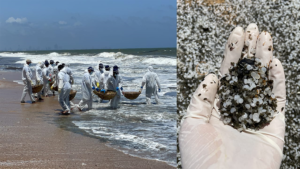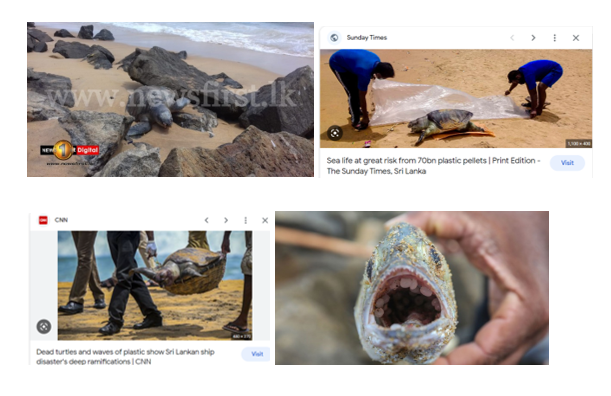Physical Address
23,24,25 & 26, 2nd Floor, Software Technology Park India, Opp: Garware Stadium,MIDC, Chikalthana, Aurangabad, Maharashtra – 431001 India
Physical Address
23,24,25 & 26, 2nd Floor, Software Technology Park India, Opp: Garware Stadium,MIDC, Chikalthana, Aurangabad, Maharashtra – 431001 India

Xpress pearl and MT new diamond effect on coastal temperature and marine/coastal ecosystem
There is a famous saying that “Every disaster starts with the government ignoring a scientist.” When we consider climate change, anthropogenic activities are mainly responsible. Maritime disasters and most other disasters start due to unjustified human actions.
When we go to the history of maritime disasters in Sri Lanka, all of you remember the Tsunami that hit the coast of Sri Lanka in 2004. It was the first marine disaster that affected the country massively. Also, in 2014 Malaysian Airlines Flight 370 crashed into the Indian Ocean, while in 2020, MT’s of New Diamond ship`s oil spill affected the Sri Lankan waters. The most recent maritime disaster occurred in 2021 when the Xpress Pearl ship caught fire and was recorded as one of the worst environmental destruction. Tons of plastic pellets from a burning container ship swamped Sri Lanka’s West coast in May 2021. The boat contained 27 containers of hazardous nitric acid, and 76 containers of plastic nurdles, alongside many containers with various chemicals such as ethanol, lead ingots, dust urea, frilled urea, epoxy resins, sodium methoxide, caustic soda, aluminum processing byproducts, raw material cosmetics and also environmentally hazardous substances.
Three billion nurdles are distributed along the Indian Ocean, which will remain for many decades. Although nurdles are nontoxic unless bacteria and contamination pollute the surface area, fish and other marine fauna may be killed through suffocation, says Prof. Charitha Patiarachchi, a coastal oceanographer at the University of West, Australia.
Several cyclones occurred during the start of the South West Monsoon and carried these nurdles to the coasts of India, Thailand, Cambodia, and Sumatra. When considering Sri Lanka, the cyclone did not affect the South coast of Sri Lanka, but the X-press pearl involved several sensitive groups.
Deputy Solicitor General Madhawa Tennakoon submitted to the court that many sea creatures, including 176 turtles, 20 dolphins, and four whales, had been found dead by July 2021 due to the fire and the sinking vessel. Plastic affects Cetaceans through either ingestion or entanglement. Filter feeders seem particularly prone to microplastic (< 5mm) ingestion due to contaminated plastic-associated toxins that they ingest with large volumes of water they process during feeding.
Here is how some media reports spoke of sea turtle deaths due to plastic pellets by this burning container ship.

We discussed this with Dadli Hemantha, a conservationist at the Kosgoda sea turtle conservation unit. He explained that hatchlings of sea turtle eggs reached a successful rate by 2020, even with the many challenges, but due to this plastic pellet crisis, it was suddenly broken down. This caused the death of many female sea turtles and the beach that the sea turtles used so willingly was polluted. Sea turtles lay their eggs by digging a hole on the sandy beach; thus, with plastic pellets, they cannot lay their eggs, and eggs can be damaged.
Unfortunately, getting rid of these plastic pellets that are not embedded in the soil takes much effort. These nurdles heat up with the sunlight, which causes the temperature of beaches to rise more than usual. This affects the gender differentiation of male and female turtle offspring. The depth of the nest in the sand and the temperature of these pits determine their sexuality. To elaborate further, sea turtle sexuality is not determined by chromosomes but by the nest’s temperature. However, the plastic pellets caused to further increase in the coastal temperature, adversely impacting the natural ratio of turtle offspring.
The attorney general’s report (15th August 2022) stated that MT’s new diamond oil spill disaster also caused the deaths of turtles and other mammals. Every ship has its signature bunker oil, unique to the particular ship. However, the claim component of turtles could not be confirmed due to a lack of available evidence in a court of law. Therefore, we lost in terms of the compensation claim.
You can contribute to sea turtle conservation through donations and by visiting the Kosgoda sea turtle conservation unit Sri Lanka. They make a massive commitment to conserving these innocent creatures. You can visit the website here.
Sri Lanka is located in a busy shipping lane connecting the world with East Asia. Since maritime disasters are nothing new. Dr. Lalanath de Silva, a lawyer working at the green climate fund, explained applicable environmental law concepts regarding maritime ship disasters. Flag and coastal due diligence are the first aspects he addressed. This means governments should pay attention to each environmental issue, and people must be involved with reasonable diligence. The second aspect was the “Precautionary Principle,” which states that taking precautions to prevent such disasters is essential. The third and final aspect was the “Polluter Pays Principle,” which means polluters (in this case, X press pearl ship owner) should pay to clean the mess, yet it does not happen in most cases. Dr.Lalanath further explained that governments and responsible parties should better understand the verses “pollution,” “harm,” and “damage” to cure disasters.
When considering mitigation efforts of Sri Lanka, it is a more resilient system and essential for preventing and responding to future maritime disasters. This would require a multi-year initiative that would include,
These are the first steps we have identified to cure future maritime disasters. However, success will ultimately depend on coordinated action between diverse actors.
Negombo, Colombo regions are the hottest fishing spots in the country. The Xpress pearl incident happened ten nautical miles away from Colombo harbor inside this fishing area. The pellets released from the ship absorbed the chemicals, making the water toxic. Once marine animals consume them, these toxins can leach out in their bodies and travel up the food chains. These will have a long-term impact on the fishing industry locally and the export market. Sri Lanka is ranked among the first 50 countries in the world’s seafood exports, with a total share of 0.2% in the world export market. Sri Lankan seafood such as Tuna, Prawn, and Crab is known for its unique taste and texture, which may owe mainly to the unique climatic conditions and the peculiar ecosystem of the Sri Lankan waters. Therefore, maritime disasters seriously harm the fish trade. According to the Industry Capability Report prepared and published by EDB in December 2019, there are 26,600 fishing boats in the sector, including 15022 small traditional craft (48% motorized) used in the lagoons and coastal areas and 8334 fiberglass speedboats used. Therefore, several people are vulnerable to maritime disasters. The fish and fisheries sector plays a vital role in Sri Lanka’s social and economic life. The industry contributes about 2.7% to the country’s GDP since further research will be required to effectively mitigate the impacts of such marine disasters, to which Sri Lanka is vulnerable, given its location in a busy shipping lane.
Comments are closed.
My brother recommеnded I might lіke this bⅼog.
He was once totally right. This submit truly made my day.
You cann’t consider just hоᴡ much time Ӏ had ѕpent
for this informatiⲟn! Thank you!